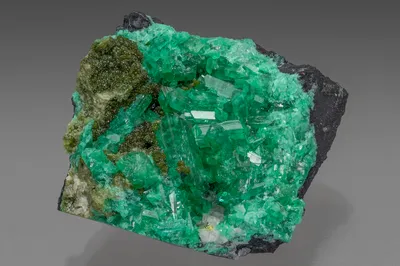Mineral Species
Lukrahnite
Type Locality
Yes
Composition
Ca(Cu,Zn)(Fe3+,Zn)(AsO4)2(OH,H2O)2
Crystal System
Triclinic
Status at Tsumeb
Confirmed (type locality)
Abundance
Extremely rare
Distribution
Second (?) oxidation zone
Paragenesis
Supergene
Entry Number
Species; TSNB218
Type Mineralogy
In the course of their study of tsumcorite group minerals, Krause et al. (1998) analysed a number of "yellow coatings" on mineral specimens from Tsumeb. Most of them turned out to be gartrellite, tsumcorite or zincgartrellite, but two of the specimens showed small but significant shifts in larger 2θ values, indicating a smaller unit cell. Microprobe analysis showed these to be specimens of a new calcium analogue of gartrellite. Lukrahnite, IMA 1999.030, was described by Krause et al. (2001) and named for German geologist and mineral collector Ludger Krahn (b.1957), who provided the first specimen for study. Type material is conserved at the Institut für Mineralogie, Ruhr-Universität Bochum, Germany (catalogue number unavailable).
General Notes
The location in the mine from which the type specimen of lukrahnite originated is not known with certainty, but the paragenesis is strongly indicative of the second oxidation zone. On the type specimen, lukhrahnite occurs as pale yellow spherical aggregates (to 0.5 mm); individual crystals (to 30 µm) are not visible to the naked eye. Lukrahnite is associated with beudantite, chalcocite, conichalcite, quartz, wulfenite and zincolivenite (Krause et al. 2001).
Lukrahnite is the calcium analogue of gartrellite, and a member of the tsumcorite group. It is the fourth member of the gartrellite sub-group, which is characterised by triclinic symmetry (Krause et al. 2001).
Associated Minerals
beudantite; chalcocite; conichalcite; quartz; sewardite; wulfenite; zincolivenite




